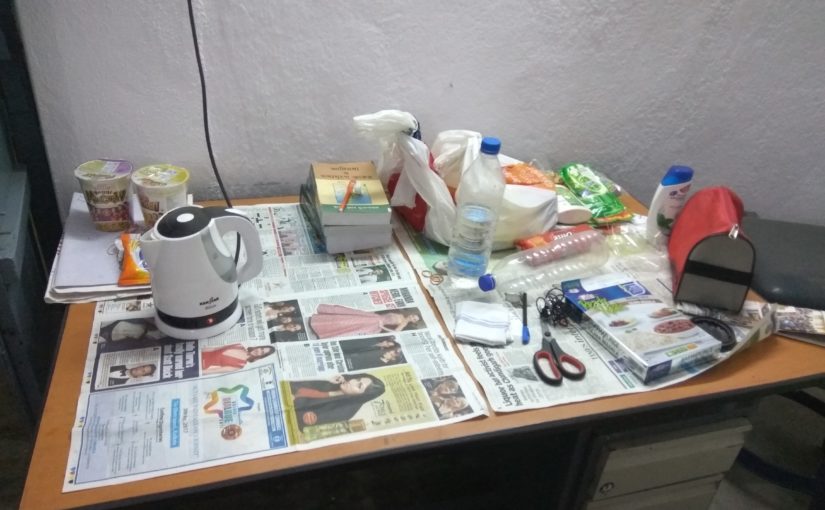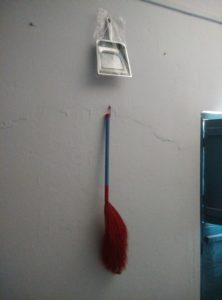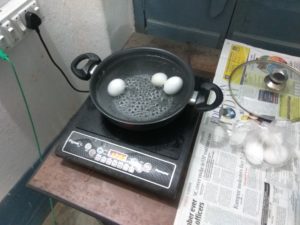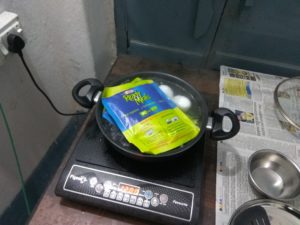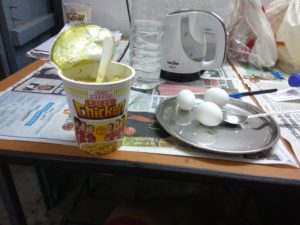It seems the favourite pastime of the average South East Asian regime is to go after one or another of its minorities, and while doing so, try to avoid international media attention. Whether it is the treatment of non-Bhumiputera groups by the Indonesian and Malayasian governments, or the treatment meted out to the Karen by Myanmar, or the treatment of Tamils by the Sri Lankan government (technically South Asia I know), there always seems to be some minority in need of being championed in the high towers of the UN. In each case, the reasons are different, and the contexts are complex. But the end result is a stream of refugees who inevitably end up on the shores of some other country, including those that implemented discriminatory policies against their own minorities. This is followed by some heart-wrenching narratives that seek to shore up support for the persecuted minority, so that the refugee burden can be shared with other “like-minded” countries.
Of course, this isn’t a solution, simply because the regimes that enforce such migrations through acts of omission and commission are seldom reformed. The bhumiputera policies implemented by the Malayasian government remain in force today, continuing inter-ethnic tensions between the majority Malays and the hitherto socially significant Chinese and Indian communities. In Myanmar, the persecution of the Karen brought about a bloody civil war, but little else. The junta didn’t change, nor did the policies. Now the junta has superficially given power over to Aun San Suu Kyi, but the internal dynamics of policy formulation remain the same. Indeed, if anything, the recent Rohingya crisis only serves to underline how meaningful change at the policy level is just not forthcoming in this part of the world. Instead, we are awash in propaganda campaigns that focus on whichever social group is being currently hounded.
This group, as of now, is the Rohingya. They’ve been dubbed the “most persecuted people in the world”, which would surely bring a wry smile to those who were till very recently living under the oppressive rule of the Taliban, or ISIS, or the various drug cartels that virtually control parts of LatAm. But we’re not here to compare and grade human suffering, since the fact of suffering is patent enough. That the Rohingya have been discriminated against and treated as pariah is not for anyone to debate, save by lack of common sense. Naturally, this has led to another propaganda campaign – and a counter-propaganda campaign by the Myanmar government – both of whom seek to place the blame on the opposite party. This would have been fine as long as, like the Karen and other groups that preceded them, the Rohingya had not ended up in India. But given that that is precisely what is happening (more on this later), we need to take a long hard look at what really is going on, and what should be our response.
First of all, let’s look at the vexed question of the origin of the Rohingya. The Rohingya claim that they arrived from parts of India long before the coming of the British, and had been settled in the regions today known as Rakhine and historically known as Arakan, for centuries. It is true that the Arakan rulers tended to maintain relations with the Sultans of Bengal, and even accepted vassal status during the 15th Century. They employed Muslims, who were skilled in statecraft, and they and their retainers lived in the modern Rakhine region since then. But as historians have pointed out, this group would form only a fraction of the total number of Rohingyas today, even if we take at face value the claim that the direct descendants of those who had lived during the Sultanate were still living as Rohingya in the region.
Much more important was the depopulation of the region by the Konbaung invasion of Arakan during the 18th Century. When the British eventually conquered the region, they sought to use the fertile valleys to enhance their tax-collection abilities. This could only be achieved if there was sufficient labour. Workers were brought from neighbouring areas to work the fields. These were usually Bengali Muslims, coming from a region already overpopulated, to a region which was then underpopulated. Over time, their number grew and they began to demand benefits from the British government, something their religious compatriots in other parts of India were also doing at around the same time. This alarmed the native Rakhine and other groups, who were Buddhists and therefore saw the growing Muslim population as a direct demographic threat to their claim over resources in the region. It didn’t help that the Bengali Muslim populace has historically had a higher population growth rate than the Rakhine, and this meant that their proportion grew steadily during the 19th Century. By the beginning of the 20th Century, conflict over land was becoming inevitable.
The Second World War and the Japanese occupation of the region proved to be a key event in the history of the Rohingya and the Rakhine. The Rohingya, by virtue of getting preferential treatment due to the traditional British policy of favouring minorities, strongly supported the British. The Japanese supported the Buddhists. The result was escalating conflict between the British-supported Rohingya V-Force (Volunteer Force) and the Buddhist groups organized with Japanese help. The British had hoped to use the Rohingya as a buffer shield against Japanese aggression. However, the sectarian nature of the conflict ensured that the V-Force used British arms to attack Rakhine villages, leading to an endless cycle of violence.
This violence convinced the Rohingya at large that they needed their own state. Demands for a separate region of northern Arakan were being raised since the early days of the 20th Century. They now merged with the Pakistan movement, only to be eventually disappointed by Jinnah, who had no wish of picking a fight with the Burmese government at a time when his moth-eaten state was just coming out of its cocoon. Thus disappointed, the Rohingya sent representatives to the Burmese Constituent Assembly and Parliament, demanding from U Nu recognition of the Rohingya as a separte group and a separate state for themselves. As one would expect of a Buddhist prime minister in a Buddhist-dominated country, U Nu largely ignored them. What hope remained of a mutually satisfactory solution ended with the coming of the military junta in 1962.
Since 1962, the junta has systematically ensured that the Rohingya are not allowed to become a political force in the Arakan region. This included denying them citizenship, access to government jobs and representation in the few representative organs that remained. Pogroms were organized against them, leading to cyclical exodii to neighbouring countries. This led the Rohingya to support practically every anti-junta movement there could be, whether it was the 8888 movement or Suu Kyi in the 1992 elections. This cycle continues today, even though the junta has relinquished formal power to Suu Kyi and a democratic process.
As the above narrative makes clear, the Rohingya are essentially ethnic Bengali Muslims who had settled in less populated lands of modern-day Myanmar, with a small portion of them going back further (and this being a matter of dispute). Their language, for all the talk of dialects, is Bengali, and their intellectuals maintained close links with the Muslim Bengali intellectuals during the Partition movement, and even after. In fact, this had led to the formation of an Arakanese version of the Muslim League in the 1940s. Their numbers, having grown exponentially, poses a threat to the demographic stability of the Arakan region, which has led indigenous groups like the Rakhine to protest, and then take up arms against them. The Myanmarese government, for its part, realized that this group was one that could not be assimilated within the logic of either Burmese nationalism (given their ties to Eastern Bengal) or Buddhist nationalism (they were Muslims). Hence, rather than keep a growing populace, they sought to extirpate them and disperse them to other regions. Dump their own perceived problem on others, in other words.
This has led to systematic persecution of the Rohingya. Beginning with denial into the officialdom of the junta state, this has reached the point of physical torture, rape, arson and other forms of assault on the Rohingya. The Rohingya, for their part, having exhausted options for peaceful protest, taken to the militancy. As with other Muslim groups who face persecution, their natural harbor has been the Islamist world of jihad. Ever since the 1980s, groups like the Rohingya Solidarity Organisation (RSO) have had jihadist links. Even recently, the Arakan Rohingya Salvation Army (ARSA) has shown itself to be a keen follower of the diktats of jihad, attacking both the Buddhists and the minuscule number of Hindus living in the region. Here, it should be pointed out, that the Hindus, like the Rohingya themselves, are a legacy of colonial rule. To attack a similarly placed social group makes no sense when seen from an ethnic minority’s viewpoint. But it does make sense when seen from a jihadist perspective.
It has been argued, with merit, that a persecuted people will fight back at a point of time. Democracy, when it functions properly, ensures that such problems are discussed and solved, and if not, brought before the public forum through protests and pressure groups. Myanmarese democracy, in the version that currently exists, has clearly failed the Rohingya. The Rohingya now want nothing to do with Myanmar’s democracy, and everything with finding a new home, and fighting back against the military and removing all except themselves from the Northern Arakan region. This has the potential of becoming a second civil war. If it does, it would ensure a swift demise for the democratic mechanism currently taking roots in the country, and further persecution and reprisals. This would produce more refugees, which is not good news for any of Myanmar’s neighbours.
Having established the ethnicity of the Rohingyas, their persecution at the hands of the Buddhist establishment and their attempts at fighting or fleeing, it is now time to turn to what India as a country should do. The most obvious answer to this would be to put diplomatic pressure on Myanmar to come to a solution. This is to pretend that India isn’t already doing what it can, or hasn’t in the past tried to influence the country. In the context of south Asian relations, Myanmar’s relations with India can be termed cordial, and while it may seem that the Indian state may be doing less than it should, one should remember that diplomatic pressure is probably not going to work anyway. Myanmar, like any small country with a xenophobic trait, is extremely sensitive to the Rohingya issue and did not think twice before bombing the Chinese border over the expulsion of groups of Chinese from the country. As for its non-Rohingya Indian populace, they have had to leave the country much earlier.
Hence, instead of doing anything for the Rohingya, any pressure on India’s part risks pushing Myanmar into the waiting arms of China, further isolating India in her immediate neighborhood. Hence, if Sushma Swaraj’s visit in March to Myanmar (and Modi’s in September last year) don’t yield anything beyond platitudes about how India believes the Rohingya would do best in Myanmar and there should be socio-economic development, don’t be surprised. You’re basically looking in the wrong place at the wrong time.
Given how this cyclical crisis isn’t going away (Myanmar has done nothing to fix its internal xenophobic traits, and has promised to take back only a minuscule number of Rohingya, who anyway do not wish to return), it should be worthwhile to look at what the crisis means for India. On the diplomatic level, India risks a full-scale spat between Bangladesh, which supports the Rohingya but shies away from accepting that they’re ethnic Bangladeshis, and Myanmar, which calls the Rohingya “Bengalis” and wants to send them back by the truckload into Bangladesh. Any spat could lead to the intervention of China, which would allow India’s arch-enemy another front in its attempt to seclude India. If Nepal is anything to go by, India should seek to ensure that any trouble, within or without a neighbouring state, doesn’t become an international issue.
But the Rohingya aren’t just a diplomatic problem. At places like Hili and Benapole in West Bengal and parts of Tripura, they’ve appeared at the border posts demanding entry. Note that these aren’t borders between India and Myanmar, but between India and Bangladesh. This naturally suggests that for all the wailing the Bangladeshi government is doing at the moment, they’re as interested as Myanmar in passing on the problem rather than solving it. When the Indian government sought to send them back, vested interests filed a case in the Supreme Court demanding (on legally dubious grounds) that India could not send the Rohingya back. The case in ongoing in the Supreme Court, with news of Rohingya atrocities against the Hindus bolstering the state’s case that the Rohingya present a security threat to India, alongside a demographic one.
It should be instructive at this point to see what the state’s arguments are. Firstly, it has argued that the Rohingya would affect the demographic makeup of the country. This may seem to be an overcautious approach given that the official UN figures for the number of refugees currently in the country hover in the range of 40,000. However, we have seen how a poor and largely illiterate populace like the Rohingya can grow in numbers, which contributed to the land problems in Rakhine in the first place. India, with its highly polarized communitarian social structure (which some would call communal), is sensitive to even fractional changes in the relative abundance of different religions. One can argue that this stems from the fierce conflicts over land in an overpopulated country, but we cannot change that. There are chances that as the numbers of the Rohingya grow, they will be polarized on issues of resource control to an extent where they become a political force by themselves.
This force, it should be remembered, wouldn’t exist in a vacuum. The recent events involving the killing of Hindus shows that the community has already been infiltrated by extremist groups pledging loyalty to jihadist outfits. In India, there is no dearth of sleeper cells that can further estrange them and create a homegrown security threat, an Indian version of ARSA. It is in this context that the government raised the security issue.
Now it has been argued that India has accepted other refugees in the past. Even if we set aside the flow of refugees into Punjab, and belatedly, into Bengal, at the time of partition, we can think of the coming of the Dalai Lama and then the influx that followed Operation Searchlight in the 1970s. In each case however, it should be remembered that the populace had a significant number of Hindus or Buddhists. The Hindus, by virtue of being a majority, managed to assimilate the newcomers, though this too caused significant problems for the state of West Bengal. The Buddhists, on the other hand, being a minority in the pan-Indian sense, posed little threat to demographic change beyond the immediate confines of Dharamsala.
The Rohingya case is different. They form part of the Bengali Muslim community for all practical purposes, and their influx would naturally bolster the number of the Muslim community in Bengal, and in India in general. Whether they are accepted whole-heartedly by the local Muslim populace is a different question. For the pan-Indian perspective though, this has the possibility of producing a demographic imbalance that could quickly spiral into communal violence. Given the growing communalization of politics under the NDA-II government, it is simply unwise to play with demographics even if it means helping a group that is truly in need of aid.
But can India do nothing ? For the most part, the answer is yes. However, India should not be averse to taking in limited numbers through a vetting process that allows us the best of the community in terms of what they can contribute to Indian society and economy. This involves creating vetting processes similar to those that exist in European countries, the crucial difference being that we should never commit to accepting a set number of refugees like Germany did. Instead, we should process cases for asylum based on individual requirements, backgrounds, criminal records, education and skills. This would naturally exclude a number from India, but I would argue that it is not in India’s interest to take in more unskilled farmers and poor labour, since India already has an abundance of those.
What would become of the remaining Rohingya ? Some of them are finding their way in through human trafficking channels. This must be stopped, to ensure the dignity of the humans themselves and also to prevent the same demographic imbalance from occurring through informal channels. The BSF and other agencies should have a clear mandate to search, arrest and throw out all Rohingya in border areas, and also in regions far away from the border, in the interests of the safety and the demographic balance of the country.
And what of the remainder, who are denied entry either formally or informally ? Indonesia and Malaysia have taken a sympathetic approach to the Rohingya problem, accepting a number into their own countries. Bangladesh, however, would perhaps be the most ideal destination. Not only was Bangladesh carved out with the express purpose of giving a homeland to the Bengali-speaking Muslims of eastern India, it claims to actually care for the Rohingya. Hence, both from an ethnic and a religious perspective, it is best that Bangladesh take the onus of accepting the majority of Rohingya refugees and integrating them within its society. India can support and even subsidize this process, as long as the country promises not to push the Rohingya into India through formal or informal channels.
By way of conclusion, it has to be admitted that it is hard to look on without acting as a humanitarian disaster unfolds near one’s country. This, in an age when rightist governments are actively talking of throwing out refugees and instituting travel bans on Muslim countries. India, with its diverse populace, needs to be sympathetic to the plight of the Rohingyas and do what it can to diplomatically solve the problem, but ensure that her concern doesn’t end up creating political, religious or demographic challenges for future generations. In other words, India must be sensible while being sensitive.
